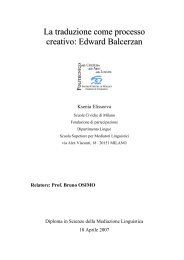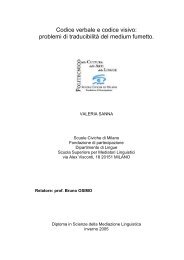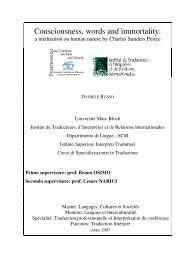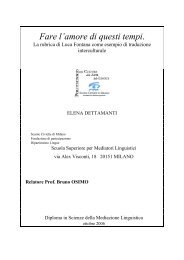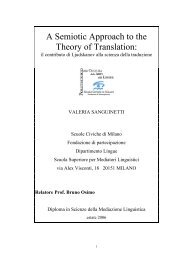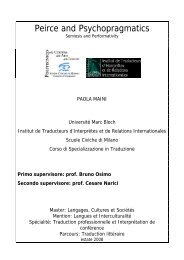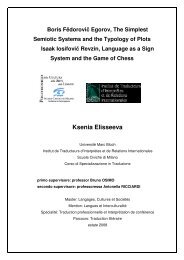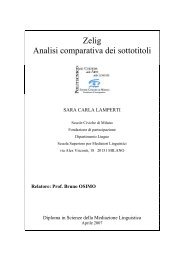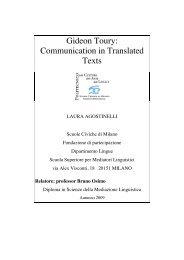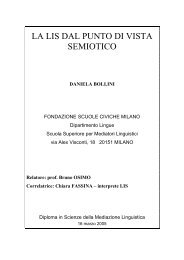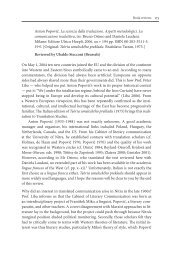Relatore: Professor Bruno OSIMO - Bruno Osimo, traduzioni ...
Relatore: Professor Bruno OSIMO - Bruno Osimo, traduzioni ...
Relatore: Professor Bruno OSIMO - Bruno Osimo, traduzioni ...
Create successful ePaper yourself
Turn your PDF publications into a flip-book with our unique Google optimized e-Paper software.
impact on psycholinguistic research, including research on second language<br />
learning, and, via L2 research, on translation studies (Jääskeläinen 1999).<br />
“There has always been a kind of empirical research, like translation<br />
criticism and error analysis, but this was product- and not process-oriented”<br />
(Kussmaul and Tirkkonen-Condit: 177). In fact, when comparing the target<br />
text with the source text or when looking at errors, one could at best speculate<br />
in retrospect about what had occurred in the translator’s mind during<br />
translation. What was needed was a way to discover what actually happens,<br />
“to get a glimpse into the ‘black box’, as it were” (Kussmaul and Tirkkonen-<br />
Condit: 178).<br />
In this sense, viewing translation mainly as a problem-solving activity,<br />
some scholars proposed that it should be possible to study it by means of<br />
TAPs, and set up experiments to test this hypothesis. The different interests<br />
and backgrounds of the researchers involved have resulted in a large variety of<br />
independent approaches (Bernardini 1999).<br />
This kind of analyses increases our potential for describing and<br />
explaining the translation processes, and thus our theoretical understanding;<br />
moreover, they have at least two pedagogical purposes. (1) The different<br />
strategies observed in the TAPs may serve as models for successful translating<br />
(Lörscher 1992a; Jääskeläinen 1993; Krings 1988; Kussmaul 1993). (2) If<br />
translation students are used as subjects, TAPs may be used to find out where<br />
they have problems. The data collected can then form a basis for translation<br />
pedagogy (Krings, 1988; Kussmaul, 1989a+b, 1994). It might be argued that<br />
teachers of translation, from years of experience, already know which<br />
strategies to recommend to learners. But sometimes they draw the wrong<br />
conclusions from their students’ translations. Teachers may, for instance, have<br />
the impression that students have problems with text-comprehension while,<br />
when talking to them, they find that students actually have problems<br />
expressing what they had understood. TAPs can help teachers to see matters<br />
more clearly (Kussmaul and Tirkkonen-Condit).<br />
19



